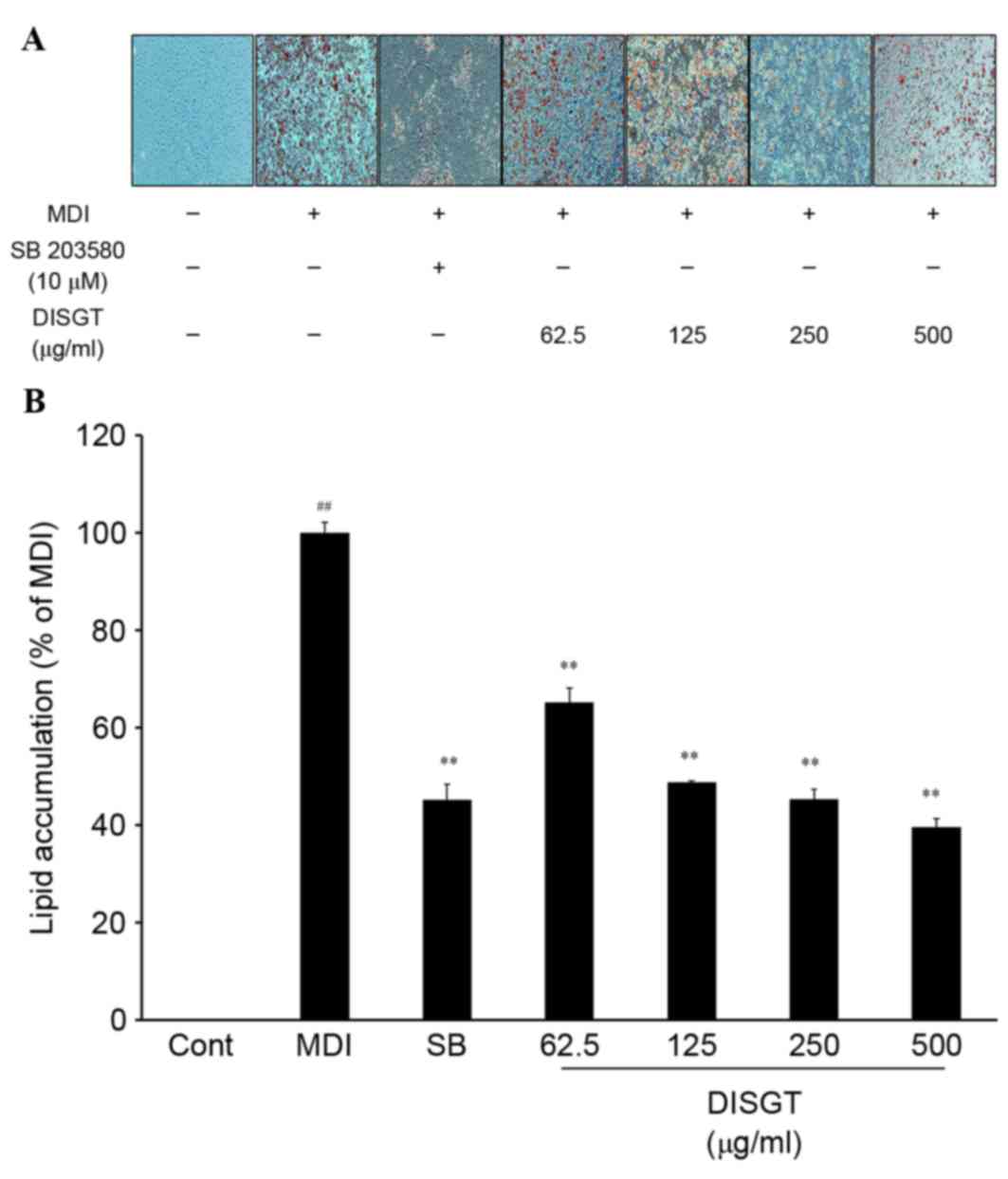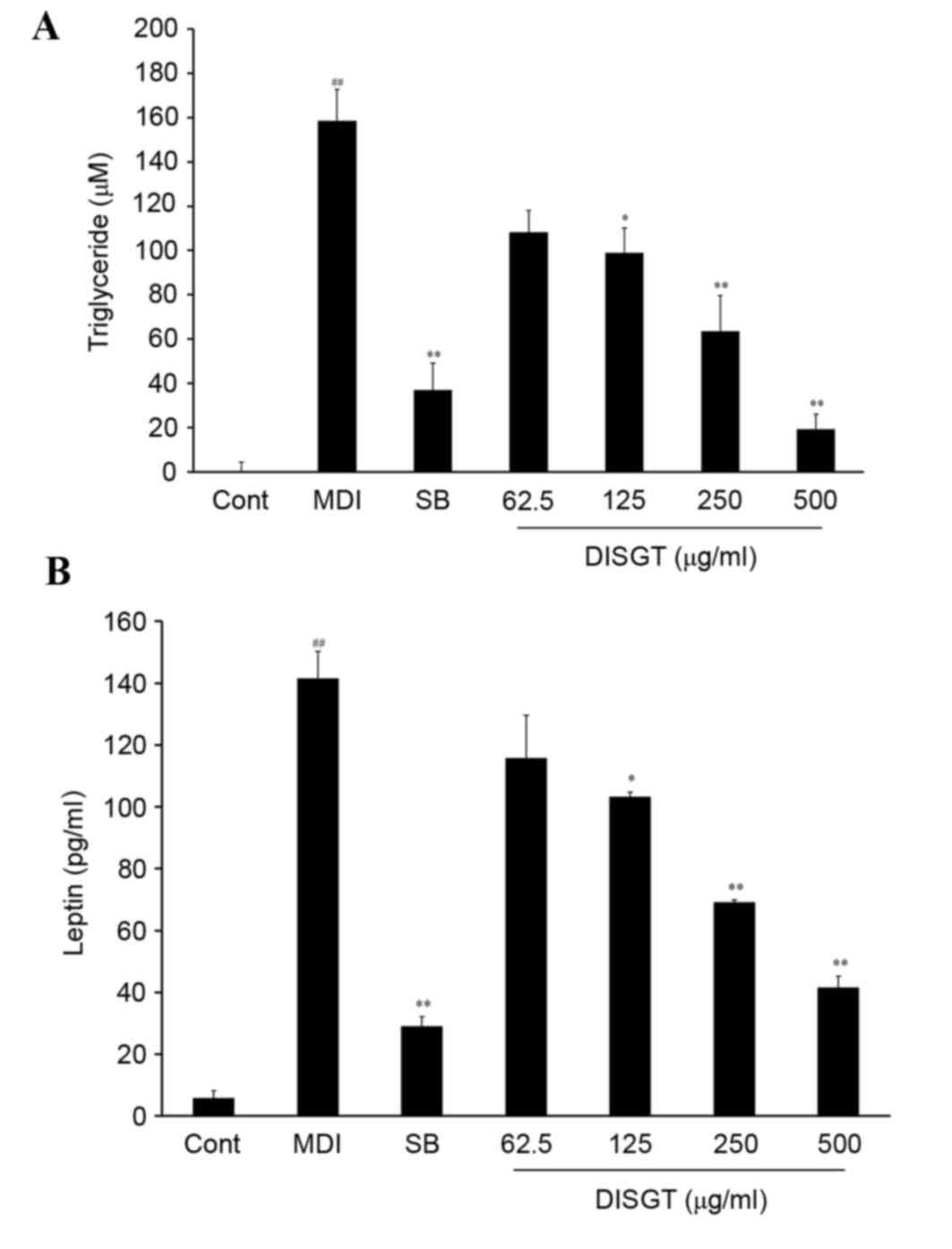|
1
|
Eckel RH, Grundy SM and Zimmet PZ: The
metabolic syndrome. Lancet. 365:1415–1428. 2005. View Article : Google Scholar : PubMed/NCBI
|
|
2
|
Kaur J: A comprehensive review on
metabolic syndrome. Cardiol Res Pract. 2014:9431622014.PubMed/NCBI
|
|
3
|
Shin SS, Jung YS, Yoon KH, Choi S, Hong Y,
Park D, Lee H, Seo BI, Lee HY and Yoon M: The Korean traditional
medicine gyeongshingangjeehwan inhibits adipocyte hypertrophy and
visceral adipose tissue accumulation by activating PPARalpha
actions in rat white adipose tissues. J Ethnopharmacol. 127:47–54.
2010. View Article : Google Scholar : PubMed/NCBI
|
|
4
|
Pakala R, Kuchulakanti P, Rha SW, Cheneau
E, Baffour R and Waksman R: Peroxisome proliferator-activated
receptor gamma: Its role in metabolic syndrome. Cardiovasc Radiat
Med. 5:97–103. 2004. View Article : Google Scholar : PubMed/NCBI
|
|
5
|
Farmer SR: Regulation of PPARgamma
activity during adipogenesis. Int J Obes (Lond). 29 Suppl
1:S13–S16. 2005. View Article : Google Scholar : PubMed/NCBI
|
|
6
|
Li SM, Xu H and Chen KJ: The diagnostic
criteria of blood-stasis syndrome: Considerations for
standardization of pattern identification. Chin J Integr Med.
20:483–489. 2014. View Article : Google Scholar : PubMed/NCBI
|
|
7
|
Zhou XQ, Liang H, Sun X and Zhou HT:
Correlation between TCM blood stasis pattern of coronary heart
disease and coronary angiography result: A meta-analysis. Chin J
Evid Based Med. 12:1470–1477. 2012.
|
|
8
|
Ji W, Zhou J, Wang S and Ji Z: Logistic
regression analysis of relevance between different blood stasis
syndromes and related factors in angina pectoris patients. Chin
Arch Tradit Chin Med. 7(040)2013.(In Chinese).
|
|
9
|
Yu X, Zhang L and Xu H: Progress in
research on relevant factors affecting TCM syndrome differentiation
of CHD. Chin J Int Med Cardio/Cerebrovasc Dis. 7:581–584. 2009.(In
Chinese).
|
|
10
|
Heo J: Donguibogam. Namsandang Publ.
Corp.; Seoul: pp. 4622014
|
|
11
|
Lee YJ, Kim EK, Kim HY, Yoon JJ, Lee SM,
Lee GM, Kang DG and Lee HS: Therapeutic effect of doinseunggi-tang
on diabetic vascular dysfunction. HFS. 21:119–130. 2013.
|
|
12
|
Kosuge T, Ishida H and Ishii M: Studies on
active substances in the herbs used for oketsu (‘stagnant blood’)
in Chinese medicine. II. On the anticoagulative principle in
persicae semen. Chem Pharm Bull (Tokyo). 33:1496–1498. 1985.
View Article : Google Scholar : PubMed/NCBI
|
|
13
|
Ge RY, Zhou CH and She YC: Influences of
stigma croci and semen persicae on function of ovary-uterus in
pseudopregnant rats. J Tradit Chin Med. 3:23–26. 1983.PubMed/NCBI
|
|
14
|
Orban T, Palczewska G and Palczewski K:
Retinyl ester storage particles (retinosomes) from the retinal
pigmented epithelium resemble lipid droplets in other tissues. J
Biol Chem. 286:17248–17258. 2011. View Article : Google Scholar : PubMed/NCBI
|
|
15
|
Columba-Cabezas S, Iaffaldano G, Chiarotti
F, Alleva E and Cirulli F: Early handling increases susceptibility
to experimental autoimmune encephalomyelitis (EAE) in C57BL/6 male
mice. J Neuroimmunol. 212:10–16. 2009. View Article : Google Scholar : PubMed/NCBI
|
|
16
|
Engelman JA, Lisanti MP and Scherer PE:
Specific inhibitors of p38 mitogen-activated protein kinase block
3T3-L1 adipogenesis. J Biol Chem. 273:32111–32120. 1998. View Article : Google Scholar : PubMed/NCBI
|
|
17
|
Chen KJ: Blood stasis syndrome and its
treatment with activating blood circulation to remove blood stasis
therapy. Chin J Integr Med. 12:891–896. 2012. View Article : Google Scholar
|
|
18
|
Spiegelman BM and Flier JS: Adipogenesis
and obesity: Rounding out the big picture. Cell. 87:377–389. 1996.
View Article : Google Scholar : PubMed/NCBI
|
|
19
|
Sartipy P and Loskutoff DJ: Monocyte
chemoattractant protein 1 in obesity and insulin resistance. Proc
Natl Acad Sci USA. 100:pp. 7265–7270. 2003; View Article : Google Scholar : PubMed/NCBI
|
|
20
|
Wofford MR, Andrew ME, Brown A, King D,
Pickett RA, Stevens J, Wyatt S and Jones DW: Obesity hypertension
in the atherosclerosis risk in communities cohort: Implications of
obesity guidelines. J Clin Hypertens. 1:27–32. 1999.
|
|
21
|
Pi-Sunyer FX: The obesity epidemic:
Pathophysiology and consequences of obesity. Obes Res. 10 Suppl
2:S97–S104. 2002. View Article : Google Scholar
|
|
22
|
Yoon JJ, Lee YJ, Park OJ, Lee SM, Lee YP,
Cho NG, Kang DG and Lee HS: Doinseunggitang ameliorates endothelial
dysfunction in diabetic atherosclerosis. Evid Based Complement
Alternat Med. 2013:7835762013. View Article : Google Scholar : PubMed/NCBI
|
|
23
|
Sung YY, Kim DS, Choi G, Kim SH and Kim
HK: Dohaekseunggi-tang extract inhibits obesity, hyperlipidemia,
and hypertension in high-fat diet-induced obese mice. BMC
Complement Altern Med. 14:3722014. View Article : Google Scholar : PubMed/NCBI
|
|
24
|
Chen Q: Pharmacology and application of
Chinese herbs. 16th. SMC Publ. Inc.; Taipei: pp. 4511989, (In
Chinese).
|
|
25
|
Fasshauer M and Paschke R: Regulation of
adipocytokines and insulin resistance. Diabetologia. 46:1594–1603.
2003. View Article : Google Scholar : PubMed/NCBI
|
|
26
|
Rosen ED and Spiegelman BM: Adipocytes as
regulators of energy balance and glucose homeostasis. Nature.
444:847–853. 2006. View Article : Google Scholar : PubMed/NCBI
|
|
27
|
Shao D, Rangwala SM, Bailey ST, Krakow SL,
Reginato MJ and Lazar MA: Interdomain communication regulating
ligand binding by PPAR-gamma. Nature. 396:377–380. 1998. View Article : Google Scholar : PubMed/NCBI
|
|
28
|
Lefterova MI and Lazar MA: New
developments in adipogenesis. Trends Endocrinol Metab. 20:107–114.
2009. View Article : Google Scholar : PubMed/NCBI
|
|
29
|
Havel PJ: Role of adipose tissue in
body-weight regulation: Mechanisms regulating leptin production and
energy balance. Proc Nutr Soc. 59:pp. 359–371. 2000; View Article : Google Scholar : PubMed/NCBI
|
|
30
|
Auwerx J and Staels B: Leptin. Lancet.
351:737–742. 1998. View Article : Google Scholar : PubMed/NCBI
|
|
31
|
Isaia GC, D'Amelio P, Di Bella S and
Tamone C: Is leptin the link between fat and bone mass? J
Endocrinol Invest. 28(Suppl 10): S61–S65. 2005.
|
|
32
|
Liu M and Liu F: Regulation of adiponectin
multimerization, signaling and function. Best Pract Res Clin
Endocrinol Metab. 88:25–31. 2014. View Article : Google Scholar
|
|
33
|
Axelsson J, Bergsten A, Qureshi AR,
Heimbürger O, Bárány P, Lönnqvist F, Lindholm B, Nordfors L,
Alvestrand A and Stenvinkel P: Elevated resistin levels in chronic
kidney disease are associated with decreased glomerular filtration
rate and inflammation, but not with insulin resistance. Kidney Int.
69:596–604. 2006. View Article : Google Scholar : PubMed/NCBI
|
|
34
|
Lefterova MI, Zhang Y, Steger DJ, Schupp
M, Schug J, Cristancho A, Feng D, Zhuo D, CJ Jr, Liu XS Stoeckert
and Lazar MA: PPARgamma and C/EBP factors orchestrate adipocyte
biology via adjacent binding on a genome-wide scale. Genes Dev.
22:2941–2952. 2008. View Article : Google Scholar : PubMed/NCBI
|
|
35
|
Tang QQ, Zhang JW and Lane M Daniel:
Sequential gene promoter interactions of C/EBPbeta, C/EBPalpha, and
PPARgamma during adipogenesis. Biochem Biophys Res Commun.
319:235–239. 2004. View Article : Google Scholar : PubMed/NCBI
|
|
36
|
Rosen ED, Hsu CH, Wang X, Sakai S, Freeman
MW, Gonzalez FJ and Spiegelman BM: C/EBPalpha, induces adipogenesis
through PPARgamma: A unified pathway. Genes Dev. 16:22–26. 2002.
View Article : Google Scholar : PubMed/NCBI
|
|
37
|
Schoonjans K, Staels B and Auwerx J: The
peroxisome proliferator activated receptors (PPARS) and their
effects on lipid metabolism and adipocyte differentiation. Biochim
Biophys Acta. 1302:93–109. 1996. View Article : Google Scholar : PubMed/NCBI
|
|
38
|
Otto TC and Lane MD: Adipose development:
From stem cell to adipocyte. Crit Rev Biochem Mol Biol. 40:229–242.
2005. View Article : Google Scholar : PubMed/NCBI
|













